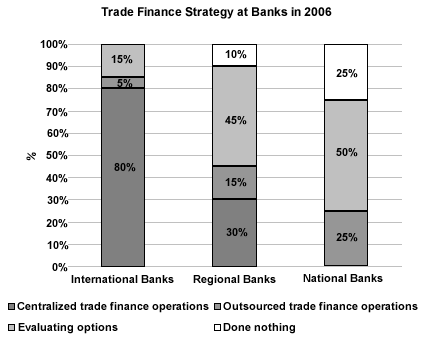| Paris, France December 9, 2003 Traditional trade finance features are doomed. Moving them to the Internet is not the answer. Trade finance solutions should move from a transaction focus solution to cash management solution. In a new report, " ," Celent provides a clear definition of the international trade business. It also provides a detailed analysis of the drivers that are remodeling trade finance operations and of the trends that are taking place in that business.
"Putting an "e" before an "LC" (letter of credit) wont make the e-LC a killer app." comments Axel Pierron, Celent Analyst and author of the report, "Firms are focused today on improving their working capital management, and the problem with trade is that its a cash trap".There are three different strategies pursued by banks to create a new trade finance proposition for corporate clients. Most banks operating in the trade finance business have moved their trade features online, for reasons of efficiency and cost reduction, either via proprietary solution or by outsourcing the operation to another institution. Even if this move has created efficiencies, reduced costs, and fulfilled clients needs, Celent believes it has failed to address the issues of todays trade finance business. This step is very similar to integrating third-party solutions such as logistics, which cannot alone completely address customer needs. According to Mr. Pierron, "The real added value to customer in the trade business today stems from the merger of trade finance with cash management. Of course, this is the most difficult step for financial institutions to make as it requires these institutions to modify their own organizations".The 36-page report contains 17 figures and 1 table. A is available online. | of Celent Communications' Wholesale Banking and Institutional Securities & Investments research services can download the report electronically by clicking on the icon to the left. Non-members should contact info@celent.com for more information. |
|





 International Trade has changed dramatically during the past 50 years. The import/export business has experienced dramatic changes due to the introduction of supply chain management techniques that have reduced the dollar size of individual shipments. In 2001, the average value of an international shipment was 42% of what it was in the 1970s. Managing the supply chain carefully reduces inventory and brings companies close to just-in-time production. This change has had a tremendous impact on the trade finance business, because traditional trade finance solutions such as letters of credit are far less relevant to this new reality of international trade business.
International Trade has changed dramatically during the past 50 years. The import/export business has experienced dramatic changes due to the introduction of supply chain management techniques that have reduced the dollar size of individual shipments. In 2001, the average value of an international shipment was 42% of what it was in the 1970s. Managing the supply chain carefully reduces inventory and brings companies close to just-in-time production. This change has had a tremendous impact on the trade finance business, because traditional trade finance solutions such as letters of credit are far less relevant to this new reality of international trade business.